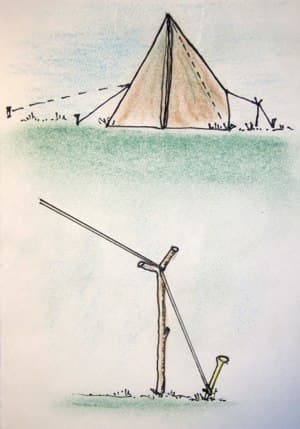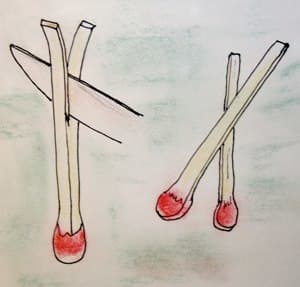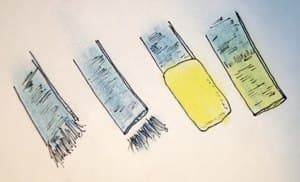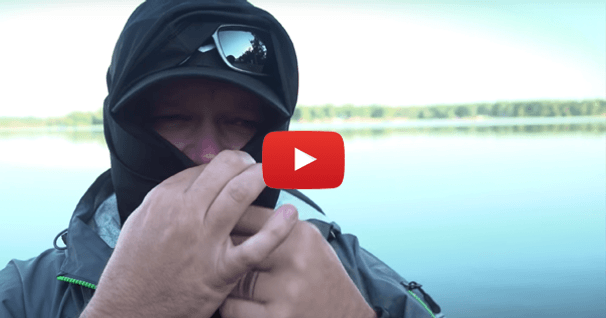Tips-n-Tricks
I've managed to acquire quite a collection of books on outdoor wilderness skills. Some I've read from cover to cover while others are used more like an encyclopedia or reference book where you zero in on a particular subject or listing. Most of my books are highlighted with markers and notes on the margins – usually to draw attention to something I know I'm going to be looking for later.
Here are a few of those items I found recently while going through a few books that hadn't been used in a while. Some may be more seasonal than others, but in the long run they are handy bits of useful information any good outdoors person can utilize across many outdoor activities.
The "Y-stick"
Even if you’ve never set up a 'pup' tent or used a makeshift tarp as a shelter, knowing how to use a Y-stick can come in handy. Even a dome tent with self-supporting sides may be made even more comfortable if Y-sticks are used to get extra lift out of window flaps or side guy lines. The utility of a Y-stick is that you can increase the angle of tension on a tarp or tent without needing to use extra line.

When a line pulls on the side of a tent or is used to extend a window flap, the longer the line the wider or more horizontal the pull on the tent. Sometimes you don’t have line long enough or you are limited by space. A Y-stick can be used to raise the angle of the line without increasing its length. This will pull out the side of a tent to give it more side room or in the case of a window awning flap, raise the flap up and out to provide more of an opening while still protecting the elements from entering the opening.
Y-sticks are usually made from a stout branch at least one-half inch in diameter. They can be used to give most any line a little lift.
A bucket in your pocket
That's what I call carrying a couple of Zip-loc type bags along in coat or pants pockets. They are great for dipping up small quantities of water from depressions in the grass or trickling drips from a rock face spring. Another handy container, one recommended by those who teach survival training, is a non-lubricated condom. Think about it, you know how well a balloon filled with water works – at least for a short distance. The compactness of a condom warrants it being part of the inventory. To keep the condom and the plastic bag from getting punctured made a sling out of a bandana. It offers an abrasion-resistant skin and the ends tie off nicely to form a handle.
Want to stay warm? Think COLD!
Survival trainer, Cody Lundin came up with this hand acronym to help his students keep comfy in cold weather:
C –make sure what you’re wearing is clean. Some gear loses loft and insulation performance with the accumulation of body oils, sweat and other contaminants.
O- avoid overheating which leads to excess perspiration and dehydration if you are not replacing those liquids.
L – loose clothing and layering. You need those air spaces to trap and store heat from your insides.
D – stay Dry! Practice COLD to stay warm!
Body Lube
My grandfather taught me this one summer during a fishing trip when I was a boy. When joining sections of a fishing pole (if you are ice fishing, warm up the ends first!) you can coat the female end of the ferrule with the oils coating the skin of your nose. Seriously! Rub the ferrule along the side of your nose, collect a little oil and then stick the two sections together. They will be lubricated for easy removal at the end of the trip. It works! Sure WD40 or silicon works, too... but when you don't have a can or tube of it around – this alternative tip wins by a nose!
Purifying Water with Iodine
Most outdoor enthusiasts know that you can purify drinking water with a few drops of Iodine. I refer back again to Cody Lundin (his "98.6 - The Art of Keeping Your Ass Alive!" is a must-read!), suggests unscrewing the cap on your water bottle ever so slightly after treating the water with iodine (or any other chemical method) and shake the bottle a few times. Water trapped within the grooves of the screw-in top can contain water that was not treated. One drop of the bad stuff is all it will take to make you ill so make sure you catch the stuff within the lid and grooves of the bottle, too!
Some books suggest adding a flavoring to treated water to make it more palatable. Actually a slightly off taste when using iodine is a sign that there was enough iodine added to actually work. But if you want to add flavor, know that Vitamin C will neutralize the affects of iodine if added too early. It is suggested to wait at least 30 minutes before adding a flavoring suspected of containing Vitamin C.
Splitting Matches
You are lost and cold. You come upon an open cabin. You enter to find a box with one match. Around the cabin you find a filled oil lantern, a candle and a woodstove with tender and kindling all ready to be ignited. What do you light first? ... The match!

If you are down to only a few matches, you can extend them by splitting them in half and using each half to produce a flame. These matches are very fragile and obviously won't burn as long. However, when you are down to only one match, you can quickly double your inventory by using your knife to split it the shaft of the wooden match and usually use your fingernail to split apart the layered stem on a paper match. Try this at home, no two separate with the same ease.
Toughen those strap ends
I've shared this one in prior columns. I find the tie-down nylon strap to be the very best thing for securing boats on vehicles – its standard practice everywhere. Sometime with use, other times because of cheaper/weaker materials, the ends of the straps fray. Even after being sealed with a melted edge cutter, some straps will fray after time.

Here's a quick and lasting fix (I have straps going on five years now). First, cut off the frayed end using either a sharp knife or a heated cutter unit. Have a can of that liquid plastic used to re-coat the handles on tools (available in hardware stores). Dip about two inches of the end of the freshly cut end of the strap into the thick coating. Allow it to absorb the coating for a few seconds and then carefully remove it, wiping the excess coating off on the edge of the container.
Use a knife blade or even paper toweling to gently remove any excess coating. You want the weave of the strap end to be visible below the coat. If it’s too thick it won’t allow the end of the strap to feed through the slot on the spring buckle. This coating works well on many things that develop frayed ends or edges from repeated, rough use.
The Pea-less Whistle
Any salty dawg knows that a regular "referee" whistle is worthless in a salt water environment. Why? Because the mechanism that enables to make its telltale shrill noise is a small "pea" that tumbles around inside the chamber. In salty conditions that pea gets stuck and the whistle makes no noise – thereby rendering it useless. Other rescue-type whistles don't rely on moving parts so they can be flat or multi-chambered (the Storm whistle, for example) and still make plenty of noise. Go pea-less!
Flint and Steel (another Cody Lundin original)
A popular tool to use as a striker on a flint bar fire starter has always been either the steel piece that comes with it or your knife. Some instructions will tell you to use your knife blade. That's a No-No! It's a good way to ruin your blade. Better to use the back of the knife. A good way to do that is to rough up a section of the backside and use it to create sparks. Better still, says Lundin, use a section of hacksaw blade. It's hard steel and if you use the end with the hole in it you can attach it right to the flint and steel unit for immediate access.
Another tip: Instead of stroking down with the striker onto the flint, hold the striker steady and pull up on the flint towards you. This directs a flow of sparks to the tinder without your hand following through and accidentally snuffing the sparks or tinder.
Uncurling the Birch "Match"
If you've ever tried to like a fire using a burning piece of birch bark you know that if you use just a strip or sheet of it, it is going to curl up rapidly as it burns. This usually means it's too short and quick to be used as a match but not too fast that it doesn't burn your fingers before you flick it to the ground.
If you are using a sheet of bark, either roll it into a tight tube or fold it accordion style. Both methods keep the birch from curling. The accordion fold acts like a broad match enabling you to repeatedly ignite the awaiting tinder throughout the base of the fire.
There are hundreds of handy tips one can learn to make routines in the outdoors easier and more fun. I would love to hear your tricks and tips. You can post your responses right online by clicking the "Discuss Article" link below.
Have fun and be safe out there!
Related Articles
This a follow up to a video I did where I talked about differences that you may find in dry and semi-dry…
Can you use a Greenland Paddle in a Recreational Kayak? I received this question recently from a…
Learn how to stay comfortable on the water when fishing in the cold. When you stay warm and…
Mention guns and canoe trips in the same breath and some folks are apt to go ballistic. Still, if you're…



